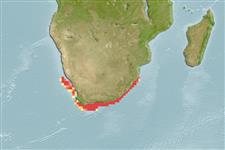Elasmobranchii (haaien en roggen) (sharks and rays) >
Carcharhiniformes (Ground sharks) >
Scyliorhinidae (Cat sharks) > Scyliorhininae
Etymology: Poroderma: poros (Gr.), hole or passage; derma (Gr.), skin or hide, allusion not explained nor evident (Smith proposed name without a description). (See ETYFish); pantherinum: Latin for leopard-like, referring to its variable leopard-like spots, stripes and blotches. (See ETYFish).
Environment: milieu / climate zone / depth range / distribution range
Ecologie
marien rifbewoner; diepte 0 - 256 m (Ref. 5578). Subtropical; 28°S - 36°S
Southeast Atlantic: Saldanha to central Natal, South Africa.
Grootte / Gewicht / Leeftijd
Maturity: Lm ? range ? - ? cm
Max length : 84.0 cm TL mannelijk / geslacht onbekend; (Ref. 244); 73.0 cm TL (female)
Korte beschrijving
Morfologie | Morfometrie
Dorsale stekels (totaal): 0; Dorsale zachte stralen (totaal): 0; Anale stekels 0; Anale zachte stralen: 0. A stocky shark with long nasal barbels and a highly variable color pattern of black spots, rings and lines in horizontal rows on a grey to whitish background; white below (Ref. 5578). There are 3 different forms, the typical 'pantherinum' with lines and rosettes of spots, and two extreme forms, 'marleyi' with large dark spots (formerly considered a separate species), and 'salt and pepper' with small, densely packed black spots, intermediates between these extremes are extremely common (Ref. 5578).
Found on or near the bottom of warm-temperate waters, from the intertidal zone to 256 m (Ref. 5578). Prefers rocky reefs (Ref. 5578). Nocturnal (Ref. 244). Feeds on small bony fish, crustaceans, octopus and polychaete worms (Ref. 5578). Oviparous (Ref. 50449). Readily kept in captivity (Ref. 244).
Levenscyclus en paargedrag
Maturiteit | Voortplanting | Paaien | Eieren | Fecunditeit | Larven
Oviparous, produces one egg per oviduct (Ref. 5578). Embryos feed solely on yolk (Ref. 50449).
Compagno, L.J.V., D.A. Ebert and M.J. Smale, 1989. Guide to the sharks and rays of southern Africa. New Holland (Publ.) Ltd., London. 158 p. (Ref. 5578)
Status op de Rode Lijst van het IUCN (Ref. 130435)
Gevaar voor de mens
Harmless
Gebruik door de mens
Visserij: visserij voor eigen gebruik; sportvis: ja
Meer informatie
Leeftijd/GrootteGroeiLengte-gewichtLengte-lengteLengtefrequentiesMorfometrieMorfologieLarvenLarvale populatiedynamiekRekruteringAbundantieBRUVS
ReferentiesAquacultuurAquacultuurprofielKweeklijnenGeneticaElectrophoresesErfelijkheidZiektesVerwerkingNutrientsMassaconversie
Tools
Speciale rapporten
Download XML
Internetbronnen
Estimates based on models
Preferred temperature (Ref.
123201): 12.4 - 22.1, mean 16.3 °C (based on 31 cells).
Fylogenetische diversiteitsindex (Ref.
82804): PD
50 = 0.7500 [Uniqueness, from 0.5 = low to 2.0 = high].
Bayesian length-weight: a=0.00263 (0.00139 - 0.00497), b=3.21 (3.04 - 3.38), in cm total length, based on LWR estimates for this (Sub)family-body shape (Ref.
93245).
Trofisch niveau (Ref.
69278): 4.1 ±0.57 se; based on food items.
Weerstandsvermogen (Ref.
120179): laag, minimale populatieverdubbelingstijd 4,5-14 jaar (Fec assumed to be <100).
Fishing Vulnerability (Ref.
59153): Moderate to high vulnerability (54 of 100).
Nutrients (Ref.
124155): Calcium = 7.11 [1.51, 36.84] mg/100g; Iron = 0.352 [0.091, 1.024] mg/100g; Protein = 19.2 [16.2, 22.3] %; Omega3 = 0.125 [0.052, 0.290] g/100g; Selenium = 15.6 [4.5, 47.7] μg/100g; VitaminA = 36.5 [12.1, 119.9] μg/100g; Zinc = 0.539 [0.250, 1.132] mg/100g (wet weight);
